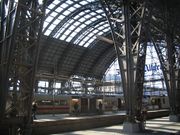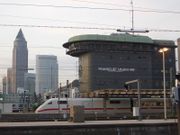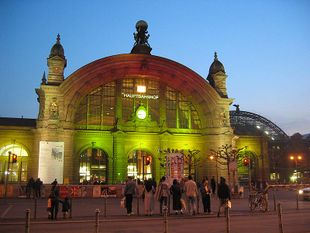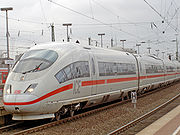Frankfurt (Main) Hauptbahnhof
| Frankfurt (Main) Hauptbahnhof | ||
|---|---|---|
 |
||
| Operations | ||
| Category | Long-distance railway hub (Fernverkehrsknoten) |
|
| Type | Terminal station | |
| Station tracks |
|
|
| Passengers |
350,000 daily[1] |
|
| Daily train services | ||
| Abbreviation |
FF |
|
| Home page | www.bahnhof.de | |
| Construction and location | ||
| Opened |
18 August 1888 |
|
| Architekten | Hermann Eggert and Johann Wilhelm Schwedler | |
| Style | Renaissance revival (facade), Neoclassicism (extensions) | |
| City/town | Frankfurt am Main | |
| Federal state | Hesse | |
| Country | Germany | |
| Coordinates: DE | ||
| Route information | ||
Underground:
|
||
| List of railway stations in Hesse | ||
Frankfurt (Main) Hauptbahnhof (usually translated from German as Frankfurt (Main) Central Station, short form: Frankfurt (Main) Hbf) is the central station for Frankfurt am Main. In terms of railway traffic, it is the busiest railway station in Germany. With about 350,000 passengers per day the station is the second most frequented railway station in Germany and one of the most frequented in Europe.
Contents |
History
Proto-history
In the late 19th century, three stations connected Frankfurt to the west, north and south, the
- Taunus station for the Taunusbahn (opened 1839), connecting Frankfurt to Wiesbaden
- Main-Neckar-station for the Main-Neckar-Eisenbahn to Darmstadt, Heidelberg and Mannheim (1848))
- Main-Weser station for the Main-Weser-Bahn to Kassel (1852) and from 1860 on also used by the Frankfurt-Bad Homburger Eisenbahn.
Those three stations were placed beside each other on the then Gallustor (today: Willy-Brandt-Platz).
Building the new station
This situation was considered impracticable due to rising passenger figures in the 19th century, so plans were laid out as early as 1866. At first, a large scale station with up to 34 platforms was considered, then the number got reduced to 18. Post and baggage handlings had their own underground facilities, and the city council demanded the station to be moved further away from the city. In the end, in 1881, the German architect Hermann Eggert won the design contest for the station hall, his runner-up in the contest, Johann Wilhelm Schwedler was made chief engineer for the steel-related works. The new station was placed about 1 km to the west of the first three stations. The platforms were covered by three iron-and-glass halls.
The station opens

On August 18, 1888, after five years of construction, the Central-Bahnhof Frankfurt was finally opened. Right on the evening of the opening day, a train ran over the buffer stop and the locomotive was damaged. Over the course of the next few years, the area eastward of the new station, the Bahnhofsviertel was built up, finishing around 1900. Until the completion of Leipzig Hauptbahnhof in 1915, Frankfurt station was the largest in Europe.
Later extensions

In 1924 two neoclassical halls were added on each side of the main hall, increasing the number of platforms to 24. During World War II, the building was partly damaged (most notably the windows in the halls covering the platforms). In 1956 the station was fully electrified. One year later, Europe's then-largest signal box was commissioned, which, having been built in a contemporary style of the time and has now become a listed building.
Starting with the construction of the B-Tunnel for the Frankfurt U-Bahn facilities in 1971, a subterranean level was added in front of the main building, featuring the city's first public escalator and including a large shopping mall, one station each for the U-Bahn and S-Bahn trains, an air raid shelter and a public car park. The subterranean stations were opened in 1978 and were built in the cut and cover method, which involved the demolition of the second northern hall and rebuilding it after the stations were completed.
Between 2002 and 2006, the roof construction, which is a listed building, was renovated. This involved the exchange of aged steel girders, reinstallation of windows that were replaced by panels after World War II and a general clean-up of the hall construction.
The operational part of the station is being remodeled as well; the old signal box has been recently replaced with an electronic signal box. This was vital to improve capacity of the station. The new signal box became operational in late 2005 and will allow faster speeds into the station (up to 60 km/h) after the remodelling of the tracks.
Architecture

The appearance of the station is divided into perron (track hall) and vestibule (reception hall). Dominant in those parts built in 1888 are neorenaissance features, the outer two halls, added in 1924 follow the style of neoclassicism. The eastern façade of the vestibule features a large clock with two symbolic statues for day and night. Above the clock, the word Hauptbahnhof and the Deutsche Bahn logo are situated.
The roof of the front hall carries a monumental statue of Atlas supporting the World on his shoulder, in this case assisted by two allegorical figures representing Iron and Steam.
Operational usage
| In brief | |
|---|---|
| Total number of tracks: | 120 |
| Number of passenger tracks above ground: |
24 main line, 1 branch, 3 tramway stations, 2 tracks each |
| below ground: | 4 S-Bahn tracks, 4 Stadtbahn tracks (3 in usage) |
| Trains (daily): |
342 long-distance 290 regional (excluding Stadtbahn and tramway) |
| Passengers (daily): |
350,000 |
The station's terminal layout has posed some unique problems ever since the late 20th century, since all trains have to change directions and reverse out of the station to continue on to their destination. This causes long turn-around times and places the passengers in the opposite direction of where they had been sitting. There have been several attempts to change this. The last project, called Frankfurt 21, was to put the whole station underground, connect it with tunnels also to the east, and so avoid the disadvantages of the terminal layout. This would be financed by selling the air rights over the area now used for tracks as building ground for skyscraper, but this soon proved unrealistic, and the project was abandoned.
Frankfurt is the third-busiest railway station outside of Japan and the busiest in Germany.
Long distance trains
As for long-distance traffic, the station profits greatly from its location in the heart of Europe; 13 of the 24 ICE lines call at the station, as well as 2 of the 3 ICE Sprinter lines. To ease the strain on the central station, some ICE lines now call at Frankfurt Airport station and at Frankfurt (Main) Süd instead at the central station.
| Preceding station | DB AG | Following station | ||
|---|---|---|---|---|
|
Mannheim
toward Berlin Ostbahnhof
|
ICE 11
reverses out
|
Kassel-Wilhelmshöhe
toward München Hbf
|
||
|
Mannheim
toward Berlin Ostbahnhof
|
ICE 12
reverses out
|
Kassel-Wilhelmshöhe
toward Zurich
|
||
|
Frankfurt Flughafen
toward Wiesbaden Hbf or Basel SBB
|
ICE 20
reverses out
|
Kassel-Wilhelmshöhe
toward Kiel
|
||
|
Mannheim
toward Basel SBB
|
||||
|
Frankfurt Flughafen
toward Stuttgart
|
ICE 22
reverses out
|
Kassel-Wilhelmshöhe
toward Hamburg-Altona
|
||
|
Frankfurt Flughafen
toward Kiel
|
ICE 31
reverses out
|
Würzburg
toward München Hbf or Regensburg
|
||
|
Mannheim
toward Basel SBB
|
||||
|
Frankfurt Flughafen
toward Dortmund
|
ICE 41
reverses out
|
Aschaffenburg
toward München Hbf
|
||
|
Frankfurt Flughafen
toward Köln
|
ICE 49 | Terminus | ||
|
Frankfurt Flughafen
toward Wiesbaden
|
ICE 50
reverses out
|
Fulda
toward Magdeburg Hbf or Dresden Hbf
|
||
|
Darmstadt
toward Saarbrücken
|
||||
|
Frankfurt Flughafen
toward Amsterdam Centraal
|
ICE 78 | Terminus | ||
|
Frankfurt Flughafen
toward Bruxelles-Midi
|
ICE 79 | |||
|
Mannheim
toward Paris Est
|
ICE 82 | |||
|
Darmstadt
toward Zurich
|
ICE 87 | |||
|
Frankfurt Flughafen
toward Dortmund
|
ICE 91
reverses out
|
Würzburg
toward Wien Westbf
|
||
|
Darmstadt
toward Konstanz
|
IC 26
Karlsruhe
reverses out
|
Friedberg
toward Binz
|
||
|
Frankfurt Flughafen
toward Hamburg-Altona/Kiel Hbf/Puttgarden
|
IC/EC 31
reverses out
|
Hanau
toward Passau
|
||
|
Darmstadt
toward Saarbrücken
|
IC 50 | Terminus | ||
|
Darmstadt
toward Salzburg
|
IC/EC 62 |
Regional trains

With regard to regional traffic, Frankfurt Hbf is the main hub in the RMV network, offering connections to Koblenz, Limburg an der Lahn, Kassel, Nidda, Stockheim, Siegen, Fulda, Gießen, Aschaffenburg, Würzburg, Mannheim, Heidelberg, Dieburg, Eberbach, Worms and Saarbrücken with fifteen regional lines calling at the main station.
S-Bahn
The subterranean S-Bahn station is the most important station in the S-Bahn Rhein-Main network, with all nine S-Bahn lines calling at the station.
| Preceding station | Rhine-Main S-Bahn | Following station | ||
|---|---|---|---|---|
|
Griesheim
toward Wiesbaden
|
Taunusanlage
toward Rödermark-Ober Roden
|
|||
|
Griesheim
toward Niedernhausen
|
Taunusanlage
toward Dietzenbach
|
|||
|
Galluswarte
toward Bad Soden
|
Taunusanlage
toward Darmstadt
|
|||
|
Galluswarte
toward Kronberg
|
Taunusanlage
toward Langen
|
|||
|
Galluswarte
toward Friedrichsdorf
|
Taunusanlage
toward Südbahnhof
|
|||
|
Galluswarte
toward Friedberg
|
||||
|
Niederrad
toward Riedstadt-Goddelau
|
Terminus | |||
|
Niederrad
toward Wiesbaden
|
Taunusanlage
toward Hanau
|
|||
Local services
Tram connections are offered by TraffiQ, with tram lines 11 and 12 (station Hauptbahnhof/Münchner Straße), 16, 17, 20, 21 and the Ebbelwei-Expreß. The lines U4 and U5 call at the subterranean Stadtbahn stop.
| Preceding station | Frankfurt U-Bahn | Following station | ||
|---|---|---|---|---|
|
Festhalle/Messe
toward Bockenheimer Warte
|
U4 |
Willy-Brandt-Platz
toward Enkheim
|
||
| Terminus | U5 |
Willy-Brandt-Platz
toward Preungesheim
|
Notes
- ↑ 1.0 1.1 1.2 1.3 "Hoch frequentierte Verkehrsdrehscheibe (High frequency transport hub)" (in German). Deutsche Bahn. http://www.bahnhof.de/site/bahnhoefe/de/sued/frankfurt__hbf/daten__und__fakten/daten__und__fakten__.html. Retrieved 22 February 2010.
Sources
- Bundesbahndirektion Frankfurt am Main: Abfahrt 1888, Ankunft 1988: 100 Jahre Hauptbahnhof Frankfurt am Main, HESTRA-Verlag, Darmstadt 1988, ISBN 3-7771-0215-6
- Volker Rödel, Der Hauptbahnhof zu Frankfurt am Main. Aufstieg, Fall und Wiedergeburt eines Großstadtbahnhofs = Arbeitshefte des Landesamtes für Denkmalpflege Hessen 8, Stuttgart 2006.
- Wolf-Christian Setzepfandt: Architekturführer Frankfurt am Main. 3. Auflage. Dietrich Reimer Verlag, Berlin August 2002, ISBN 3-496-01236-6, S. 33.
- Heinz Schomann: Der Frankfurter Hauptbahnhof. Ein Beitrag zur Architektur- und Eisenbahngeschichte der Gründerzeit, 1983, ISBN 3-42102-801-X
External links
- Panorama at the Central Station Frankfurt Hauptbahnhof
- Offizieller Plan des Frankfurter Hauptbahnhofes
|
|||||||
|
||||||||||

